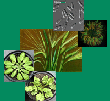| Kuhn, U; Beck, E: Conductance of needle and twig axis phloem of damaged and intact Norway spruce (Picea abies (L.) Karst.) as investigated by application of 14C in situ, Trees, 1, 207-214 (1987), doi:10.1007/BF01816817 | |
| Abstract: Phloem conductance of 14C-labelled assimilates was investigated in natural stands of Norway spruce showing substantial damage from needle yellowing and needle loss disease. Terminal current-year shoots of a branch were allowed to fix 14CO2 (300-600 ppm in air) and carbon dioxide net uptake was monitored with a gas analyser. The difference between 14C-uptake and the amount of radiocarbon determined in the photosynthesizing needles was interpreted to reflect assimilate export from the needles to the axis of the tree. Compared with an undamaged control tree, 14C-export from the assimilating needles was not impaired in the yellowing tree and only slightly reduced in the tree showing needle loss. Incorporation of 14C into starch increased significantly during autumn particularly in the tree showing needle loss. Import of radiocarbon from the Laclabelled phloem sap in twig axes and needles older than 1 year was used as a measure of phloem conductivity of older sections of a branch which showed considerable damage. Carbon uptake by these older plant parts was more pronounced than in undamaged twigs. In the case of older needles enhancement of ~4C-incorporation suggested an increased sink strength, while the same phenomenon in the twig axes was interpreted as a consequence of partially impaired conductivity of individual sieve elements resulting in an inhomogeneous velocity of phloem transport. The hypothesis is put forward that curtailed viability of the sieve cells is responsible for a delay of transport, which is compensated for by an augmented production of phloem elements from the cambium. |

